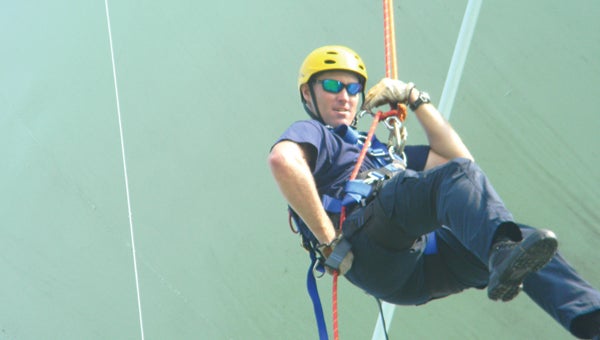Washington Fire-Rescue-EMS earns High Angle Rescue cert
Published 7:38 pm Friday, August 8, 2014

WASHINGTON FIRE-RESCUE-EMS | CONTRIBUTED
BY A THREAD: Washington Fire Captain R.M. Flowers rappelled from a local water tower during training earlier this year. Washington Fire-Rescue-EMS was recently awarded the High Angle Rescue certification by the North Carolina Association of Rescue and EMS.
The days of sitting around the firehouse, waiting for the next call are over. These days, there’s no time to waste as personnel with Washington Fire-Rescue-EMS work toward a heavy rescue certification that will give them the knowledge, and the equipment, to save lives — no matter the situation.
The department was recently issued a High Angle Rescue Certification through the North Carolina Association of Rescue and EMS, after completing the requisite training and proving to NCARE the department’s rescue truck was outfitted with the required gear: over 1,500 feet of rescue rope; 10 rescue harnesses; over 20 rescue pulleys; among a long list of other items.
Out of 1,116 fire departments in the state, only 63 are certified for high angle rescue. Washington is now one of them.
“The biggest benefit: we not only have the training, but we have the equipment,” said Capt. Johnathan Hardin. “There’s really nothing we can’t do when it comes to high angle rescue.”
The department has made do in the past: several years ago, a worker broke his leg after falling 20 feet into an empty tank at Washington’s wastewater treatment center, Hardin said. Then, they made the rescue with a crane and a Stokes basket. Now, they would do it differently, and better.
Though eastern North Carolina’s topography doesn’t put one in mind of rescues at great heights, that’s not necessarily what the certification is about. Rather, the skills learned in high angle rescue translate to any given rescue situation in which the victim’s situation and surrounding circumstances don’t make for a simple extraction. For example, in the course of industrial work, an employee has a heart attack on a high catwalk, but is not easily reachable; or a car plunges off the U.S. 17 bypass and accident victims must be stabilized and lifted on the roadway before transport. In both those cases, a rescue hinges not only on the equipment, but the knowledge that puts the pieces together — most of which is a matter of physics.
“We’d have to use a lot of our equipment for that type of rescue,” Hardin said. “The pieces are on the truck, but in rescue situations, we have to put them together.”
While the high angle rescue certification requires only eight people in a department go through the training, so far, 21 out of Washington’s Fire-Rescue-EMS 30-person squad have completed it, with the others on their way, Hardin said. Each must complete the ropes course, which over the past year has sent personnel high above the ground — on water towers, at a local grain bin — stabilizing, then safely lowering the department’s 175-pound rescue dummy, before following, by rappelling to the ground.
“I don’t think anybody really loves heights but they go up when they need to,” Hardin laughed.
Hardin has been instrumental in aiming the department toward higher certifications, according to Fire Chief Robbie Rose. Right now, the department is classified a medium rescue organization, but by the end of the year, that will have changed to heavy rescue — the department has the training, they’re just waiting for a few pieces of equipment for the rescue truck to be made official, Hardin said.
“Just saying we have the knowledge and the equipment means a lot for us and the citizens of Beaufort County,” Hardin said. “It means we can do almost anything, rescue-wise.”





